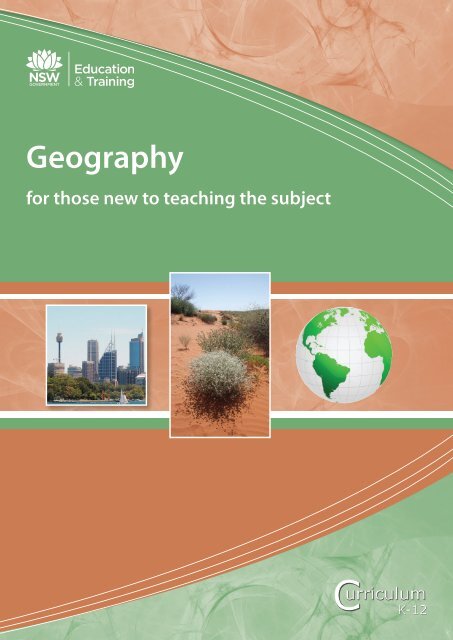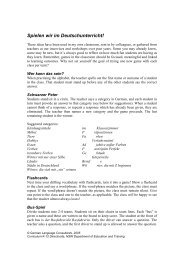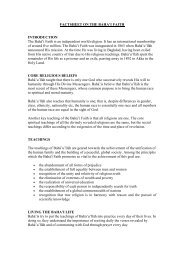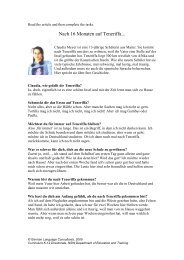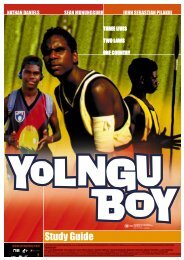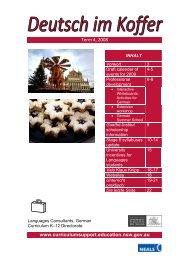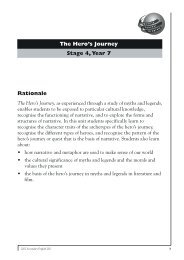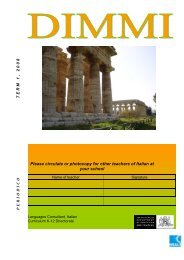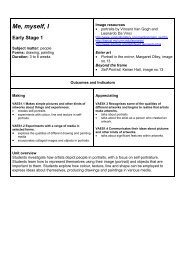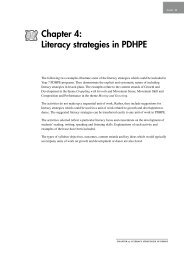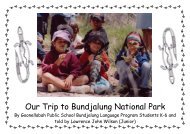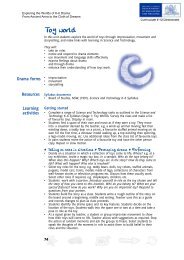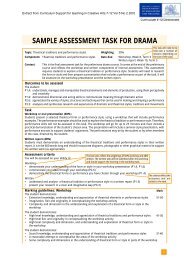Geography - Curriculum Support
Geography - Curriculum Support
Geography - Curriculum Support
Create successful ePaper yourself
Turn your PDF publications into a flip-book with our unique Google optimized e-Paper software.
<strong>Geography</strong><br />
for those new to teaching the subject
Contents<br />
About this resource 3<br />
The <strong>Geography</strong> syllabus 7–10 3<br />
Cross curriculum content 4<br />
Becoming familiar with the <strong>Geography</strong> syllabus 7–10 5<br />
Timing and teaching the <strong>Geography</strong> 7–10 syllabus 6<br />
Geographical tools 7<br />
For your reflection 10<br />
Some <strong>Geography</strong> basics 11<br />
Maps and mapping 12<br />
Weather and climate 18<br />
Designing an assessment task 29<br />
Organisations to contact for assistance with resources, teacher<br />
professional learning and excursions 35<br />
General websites for teaching and learning activities 36<br />
Online resources for maps and mapping skills 37<br />
General teaching and learning resources 38<br />
Online resources Stage 4 Teaching and Learning Exchange 38<br />
Online resources Stage 5 Teaching and Learning Exchange 39<br />
<strong>Geography</strong> for those new to teaching the subject<br />
© 2010 NSW Department of Education and Training.<br />
2
About this resource<br />
This resource is designed to help teachers new to teaching <strong>Geography</strong> with teaching <strong>Geography</strong><br />
Years 7–10. This involves gaining an understanding of:<br />
• the syllabus and its requirements<br />
• what geography is<br />
• questions asked by geographers<br />
• tools required to study geography<br />
• designing assessment tasks<br />
• professional organisations who offer assistance and resources<br />
• ideas and online resources to assist you in the teaching of <strong>Geography</strong> and the tools of<br />
<strong>Geography</strong>.<br />
The information in this resource is not designed to cover all of the subject matter or tools/skills,<br />
but to get you started on the basics including worksheets and a comprehensive list of online<br />
resources.<br />
Feel free to use any of the information and graphics in this resource in developing your<br />
teaching resources.<br />
The <strong>Geography</strong> syllabus 7–10<br />
Aim of the syllabus<br />
Rationale<br />
• To stimulate students’ enjoyment of and interest in the interaction of the physical and<br />
human environments.<br />
There are two key dimensions that form the basis of the study of all content:<br />
• The spatial dimension: where things are and why they are there.<br />
• The ecological dimension: how humans interact with environments.<br />
A study of <strong>Geography</strong> builds on students’ prior learning and experience to enable them to<br />
explain patterns, evaluate consequences and contribute to management of physical, social,<br />
cultural and built environments. (<strong>Geography</strong> syllabus 7–10 p. 8)<br />
The tools used in <strong>Geography</strong>:<br />
• Maps.<br />
• Fieldwork.<br />
• Graphs and statistics.<br />
• Photographs.<br />
<strong>Geography</strong> for those new to teaching the subject<br />
© 2010 NSW Department of Education and Training.<br />
3
Cross curriculum content<br />
Cross curriculum content is integrated throughout the <strong>Geography</strong> 7–10 syllabus. It important<br />
to note that <strong>Geography</strong> involves not just learning about things and how to do things, but also<br />
developing perspectives about issues and taking action regarding issues. Students should be<br />
given the opportunity to investigate a range of opinions and ideas, to discuss and debate issues<br />
and to learn how to make informed decisions. Quality Teaching should also be integrated into<br />
all aspects of teaching and learning in <strong>Geography</strong>.<br />
Numeracy<br />
Literacy<br />
Multicultural<br />
<strong>Geography</strong> for those new to teaching the subject<br />
© 2010 NSW Department of Education and Training.<br />
Key<br />
competencies<br />
Civics and<br />
citizenship<br />
4<br />
Cross <strong>Curriculum</strong><br />
content<br />
Difference and<br />
diversity<br />
Gender<br />
A good online starting point for Aboriginal and<br />
Indigenous content<br />
<br />
Work,<br />
employment &<br />
enterprise<br />
Aboriginal and<br />
Indigenous<br />
ICT
Becoming familiar with the <strong>Geography</strong><br />
syllabus 7–10<br />
These questions are designed to help you familiarise yourself<br />
with the course requirements. You can use the links or in the<br />
Organisations page to access the Syllabus and the School<br />
Certificate Scope and Test Specifications.<br />
1. How many hours must students study mandatory <strong>Geography</strong> in Stages 4 & 5?<br />
2. When do students study global geography and when do they study Australian geography?<br />
3. What are the four Stage 4 topics?<br />
4. What are the four Stage 5 topics?<br />
5. On what page will I find a summary of the ICT skills for students in Stages 4 and 5?<br />
6. What is the purpose of fieldwork? What are the syllabus requirements for Stages 4 and 5 regarding<br />
fieldwork?<br />
7. On what pages will I find a summary of the geographical tools for students in Stages 4 & 5?<br />
8. On what page of the syllabus is the glossary of key geographic terms?<br />
9. What is a research action plan (RAP) and which topic requires students to develop one?<br />
10. What page of the syllabus tells me the steps involved in a RAP?<br />
11. When the syllabus states ‘at least one’ case study, do I have to teach more than one? When might I<br />
choose to teach more than one?<br />
Click here to try this drop and drag activity for <strong>Geography</strong> definitions!<br />
<br />
<strong>Geography</strong> for those new to teaching the subject<br />
© 2010 NSW Department of Education and Training.<br />
5
Timing and teaching the <strong>Geography</strong> 7–10 syllabus<br />
It sounds obvious, but make sure you teach what is required in the syllabus and don’t get<br />
‘bogged down’ by textbook content overload.<br />
There is a wide variety of resources to use in <strong>Geography</strong>, including textbooks, skills workbooks,<br />
maps, geography puzzle books, ICT resources such as PowerPoint lessons, atlases including<br />
CDs, as well as an array of useful websites. Use these resources to assist and enhance your<br />
teaching; get your timing from the syllabus and teaching and learning programs in the<br />
faculty.<br />
There are great textbook resources for Stages 4 and 5 <strong>Geography</strong>, but many textbooks include<br />
a lot of in-depth material that is not always necessary. This is often because a topic will require<br />
an overview of environments or issues and then one or two in-depth studies. So, while the<br />
textbooks provide in depth information about all or many of the studies, you don’t have to<br />
teach it all – you choose from what’s available.<br />
Example 1: Focus Area 4G2 Global environments requires an overview of the environments<br />
listed and only one in-depth study (you can do more than one but this is optional).<br />
Example 2: Focus Area 4G4 Global issues and the role of citizenship requires an overview of<br />
the geographical issues listed and two in-depth studies (you can do more than two<br />
but this is optional).<br />
Example 3: Focus Area 5A1 Investigating Australia’s physical environments requires an<br />
overview of the natural hazards in Australia listed but only one in-depth study<br />
(you can do more than one but this is optional).<br />
Example 4: Focus Area 5A3 Issues in Australian environments requires an overview of the<br />
geographical issues listed and two in-depth studies (you can do more than two but<br />
this is optional). Note that one of the in-depth studies also requires fieldwork –<br />
mandatory to qualify for the School Certificate.<br />
<strong>Geography</strong> for those new to teaching the subject<br />
© 2010 NSW Department of Education and Training.<br />
Have a look at the teaching and learning programs in your faculty and consult with your<br />
subject coordinator or head teacher for the suggested timing of topics or units within<br />
topics.<br />
6
Geographical tools<br />
Through the study of <strong>Geography</strong>, students need to develop skills in working with geographical<br />
tools. These tools are outlined in the syllabus. You will find a matrix showing where these tools<br />
should be taught for Stage 4 on page 18 and for Stage 5 on page 19. In addition, every Focus<br />
Area page indicates the tools to be taught. Note students will continue to use and incorporate<br />
the Stage 4 tools in addition to the tools outlined for Stage 5.<br />
There are plenty of excellent geography skills resources available commercially, including<br />
workbooks as well as PowerPoint lessons – have a look at what’s in the staff room and peruse<br />
the catalogues sent to the school. Read through the explanations, work through the exercises.<br />
Also look out for teacher professional learning courses for <strong>Geography</strong> teachers – there are<br />
often courses specifically for teachers without a background in <strong>Geography</strong> and teachers new to<br />
teaching <strong>Geography</strong>.<br />
To help you reflect on this area of the syllabus there are two tables below, one each for Stage 4<br />
and Stage 5. As you read through the lists, indicate which tools you feel confident to teach and<br />
which ones you would like to learn more about.<br />
<strong>Geography</strong> for those new to teaching the subject<br />
© 2010 NSW Department of Education and Training.<br />
Go to the Useful websites page to find links to online teaching and learning resources<br />
for Geographical Tools.<br />
Where to access specialist tools such as compasses, stopwatches, trundle wheels, weather<br />
instruments, clinometers, tape measures, vegetation identification charts, water quality testing<br />
kits, soil testing kits:<br />
• The HSIE or Social Sciences faculty should have some tools.<br />
• Other faculties including Science, Maths and PDHPE should have tools.<br />
• Some of these tools might not be available at your school – this is where an excursion to<br />
the local Environmental Education Centre comes in handy.<br />
• It is possible for the faculty to purchase instruments from educational/science suppliers.<br />
• It is also possible to make some of the tools, such as a clinometer or a dip net.<br />
Whilst geographical information systems (GIS) is not prescribed in the syllabus, it is suggested<br />
(page 19). It’s a great way to engage students – go to About GIS in the TaLe website!<br />
7
Geographical tools reflection Stage 4 Confident Developing<br />
Maps<br />
Use an atlas<br />
Use various types of maps (physical, political, topographic, thematic)<br />
Identify and use elements of maps (legend, direction, title, scale,<br />
border)<br />
Distinguish between different types of map projections<br />
Locate features on a map: latitude & longitude; area & grid references<br />
Identify physical and cultural features on a map<br />
Measure distances on a map using a linear scale<br />
Identify scale as written, linear or representative fraction<br />
Use the points of a compass to determine direction<br />
Identify & interpret relief using shading, spot heights, colour, contour<br />
lines<br />
Construct a sketch map<br />
Read synoptic charts: wind direction & speed, pressure patterns, fronts,<br />
rainfall<br />
Fieldwork<br />
Use geographical instruments, including:<br />
• A compass to determine direction<br />
• A clinometer and tape<br />
• Weather instruments, a Beaufort wind scale, cloud identification<br />
charts<br />
• Vegetation identification charts<br />
Collect and record data in the field, including:<br />
• Design and conduct interviews<br />
• Construct and implement surveys<br />
• Field sketch, diagram<br />
Graphs and statistics<br />
Identify and calculate maximum, minimum, total, range, rank and<br />
average including on a climate graph<br />
Construct & interpret bar, column, line climatic & proportional graphs<br />
Photographs<br />
Draw a line drawing<br />
Distinguish between oblique, aerial, ground level photographs and<br />
satellite imagery<br />
Collect and interpret photographic images<br />
<strong>Geography</strong> for those new to teaching the subject<br />
© 2010 NSW Department of Education and Training.<br />
8
Geographical tools reflection Stage 5 Confident Developing<br />
Maps<br />
Use various types of maps and flow charts<br />
Locate features using degrees and minutes of latitude & longitude<br />
Calculate the area of a feature<br />
Calculate the density of a feature<br />
Measure bearings on a map<br />
Calculate local relief<br />
Identify the aspect of a slope<br />
Construct a cross-section<br />
Calculate the gradient of a slope<br />
Construct a transect<br />
Construct a land-use map<br />
Describe and explain relationships on maps<br />
Read and interpret synoptic charts<br />
Distinguish between large-scale and small-scale maps<br />
Fieldwork<br />
Develop a research action plan<br />
Use fieldwork techniques to collect primary and secondary data<br />
Graphs and statistics<br />
Construct and interpret population pyramids<br />
Construct and interpret divided bar and column graphs and composite<br />
line graphs<br />
Recognise and account for change using statistical data<br />
Photographs<br />
Interpret satellite images<br />
Collect and use digital images<br />
Collect and interpret photographic images<br />
<strong>Geography</strong> for those new to teaching the subject<br />
© 2010 NSW Department of Education and Training.<br />
9
For your reflection<br />
Answer the following questions with reference to your current school’s teaching and learning programs –<br />
this is for your reflection only.<br />
For which of the topics in Stage 4 and Stage 5 do you have good background knowledge?<br />
For which of the topics in Stage 4 and Stage 5 will you need to do some reading/research?<br />
For which of the topics in Stage 4 and Stage 5 will you need to a lot of reading/research?<br />
<strong>Geography</strong> for those new to teaching the subject<br />
© 2010 NSW Department of Education and Training.<br />
10
Some <strong>Geography</strong> basics<br />
What is geography?<br />
<strong>Geography</strong> is the study of people and places and their interactions.<br />
There are two dimensions through which we study <strong>Geography</strong>:<br />
• Spatial dimension<br />
– Where things are and why they are there. Example: distribution of global rainforests.<br />
• Ecological dimension<br />
– Human interaction with environments. Example: clearing of global rainforests for<br />
agriculture.<br />
Questions geographers ask:<br />
• What is there?<br />
• Where is it?<br />
• Why is it there?<br />
• What are the effects of it being there?<br />
• How and why is it changing over time?<br />
• Should it be like this?<br />
• What groups are involved?<br />
• What do different groups think?<br />
• What action is appropriate?<br />
Fieldwork<br />
<strong>Geography</strong> for those new to teaching the subject<br />
© 2010 NSW Department of Education and Training.<br />
11<br />
Syllabus page 20<br />
Go to the TaLe website Secondary section, select HSIE and Stage 4 and Stage 5 options and<br />
search for ‘field work’ to find excellent resources/activities to use:<br />
There are more ideas and resources for fieldwork in the Fieldwork pages!
Maps and mapping<br />
As you are no doubt aware, maps are a huge part of <strong>Geography</strong>! Students should be familiar<br />
with maps, atlases and globes from primary school. For example, NSW Stage 3 outcomes<br />
include:<br />
• uses maps and globes to locate global and Australian reference points, e.g. hemispheres,<br />
political states, lines of latitude and longitude, mountains and oceans, physical and<br />
cultural regions<br />
• locates places on a globe that they hear about or view in written, media and electronic<br />
texts<br />
• draws accurate sketch maps of a known area and includes title, key, scale and direction<br />
• uses geographical terminology and tools to locate and investigate environments.<br />
The 7–10 syllabus requires the integration of mapping tools into the teaching and learning<br />
program.<br />
Some useful tips, activities and worksheets to get you started, follow.<br />
Some fun acronyms to help teaching about maps!<br />
Teach Year 7 mapping conventions through BOLTS<br />
– what every good map should have:<br />
• Border<br />
• Orientation (north point/direction)<br />
• Legend (key)<br />
• Title<br />
• Scale<br />
Teach direction and compasses through NESW<br />
• Never<br />
• Eat<br />
• Soggy<br />
• Weetbix<br />
<strong>Geography</strong> for those new to teaching the subject<br />
© 2010 NSW Department of Education and Training.<br />
12<br />
What’s<br />
wrong with this<br />
map?
Different types of maps<br />
Physical: illustrate the physical features of an area<br />
such as mountains, rivers, coasts.<br />
Political: illustrate state and national boundaries,<br />
capital cities and major cities.<br />
Topographic: depict the<br />
shape of the land, using<br />
contour lines, as well as<br />
important features.<br />
Thematic: based on<br />
a particular theme<br />
or topic, e.g. global<br />
sanitation, distribution of<br />
resources, weather.<br />
<strong>Geography</strong> for those new to teaching the subject<br />
© 2010 NSW Department of Education and Training.<br />
13
Map projections<br />
A map projection refers to the way the sphere of the Earth (3D) is represented on a map (flat<br />
surface). When the features of the Earth are transferred from a globe onto a map they are<br />
distorted – they might look stretched, for instance. Look at the following maps as an example:<br />
The <strong>Geography</strong> textbooks/CDs have good explanations and illustrations of different<br />
map projections.<br />
The <strong>Geography</strong> for kids website has a good explanation of map projections with<br />
graphics which makes it easy to understand. You can go to and<br />
search for map projections.<br />
<strong>Geography</strong> for those new to teaching the subject<br />
© 2010 NSW Department of Education and Training.<br />
14
Latitude and longitude<br />
Lines of latitude and longitude are imaginary lines which allow us to find locations on a map of<br />
the world or part of the world.<br />
Lines of latitude Lines of longitude<br />
• run horizontally<br />
• run parallel to each other<br />
• known as parallels<br />
• measured in degrees north and south of<br />
the equator between 0° and 90°<br />
• can be further subdivided into minutes (’)<br />
and seconds (”)<br />
• begin from the Equator at 0°<br />
• quoted first.<br />
<strong>Geography</strong> for those new to teaching the subject<br />
© 2010 NSW Department of Education and Training.<br />
Sydney’s location:<br />
15<br />
• run vertically<br />
• run from the North Pole to the South Pole<br />
• known as meridians<br />
• measured in degrees east and west of the<br />
prime meridian between 0° and 180°<br />
• can be further subdivided into minutes (’)<br />
and seconds (”)<br />
• begin from the prime meridian at 0°<br />
which runs through Greenwich and<br />
London<br />
• quoted second.<br />
33° 52’S 151°12’E<br />
Latitude – think flat Longitude – think long<br />
Practise makes perfect!<br />
Play the latitude and longitude Map match game.<br />
Listen to the latitude longitude song at ‘<strong>Geography</strong> at the movies’ (but<br />
reinforce that latitude comes before longitude!)
Grid references and Area references<br />
Grid lines are used to locate a feature on a map such as a topographic map. The map is divided<br />
into a grid. Grid lines running up and down a map are known as eastings because they increase<br />
in number value as we look to the east. Grid lines running across a map are known as northings<br />
because they increase in number value as we look to the north.<br />
Grid references Area references<br />
• have 6 numbers<br />
• e.g. 256308<br />
• used to pin point the exact location of a<br />
feature<br />
• eastings are quoted before northings<br />
• e comes before n in the alphabet<br />
How to remember how to find a feature from<br />
a grid or area reference<br />
LEAN:<br />
• Look<br />
• East<br />
• And<br />
• North<br />
<strong>Geography</strong> for those new to teaching the subject<br />
© 2010 NSW Department of Education and Training.<br />
16<br />
• have 4 numbers<br />
• e.g. 2530<br />
• used to find the area containing a feature<br />
• eastings are quoted before northings<br />
• e comes before n in the alphabet<br />
The <strong>Geography</strong> textbooks/CDs have good explanations, illustrations and activities for<br />
latitude and longitude, as well as grid and area references. There is also a wide range of<br />
geography skills books and puzzles books with plenty of practice exercises. Also, go to<br />
the page to find links to online activities and resources.<br />
X
Synoptic charts<br />
Synoptic charts are simply weather maps. Synoptic charts show the atmospheric conditions<br />
of a location on a particular day including rainfall, air pressure (atmospheric pressure), wind<br />
speed and wind direction. The Australian Bureau of Meteorology website has up-to-date<br />
four day forecasts showing synoptic charts which are an engaging resource for students to<br />
learn with. The BOM also has a great resource about forecasting the weather with diagrams,<br />
explanations and activities.<br />
• Air pressure means the weight of the air.<br />
• Air pressure is measured in hectoPascals (hPa) and indicated by isobars which are lines<br />
joining places of equal pressure.<br />
• High air pressure (> 1013 hPa) means the air is heavy/sinking; associated with calm<br />
conditions and fine weather; winds move in an anti-clockwise direction in the southern<br />
hemisphere.<br />
• Low air pressure (< 1013 hPa) means the air is light/rising; associated with unstable<br />
conditions and rainy weather; winds move in a clockwise direction in the southern<br />
hemisphere.<br />
• A front is the boundary between two air masses.<br />
• A cold front is when a mass of cold air moves towards a mass of warm air pushing it<br />
upwards and is indicated by a line with spikes (think of freezing cold icicles); generally<br />
brings north or north west wind and a drop in pressure leading to falling temperatures,<br />
wind and rain but this depends on the actual temperature and water content of the air<br />
masses, which depend on the region over which the air masses originate.<br />
• A warm front is when a mass of warm air moves towards a mass of cold air pushing it<br />
downwards and is indicated by a line with bumps (think of melting icicles); moves at<br />
half the speed of a cold front; warm fronts generally occur in high latitudes and are not<br />
common in Australia.<br />
• A trough is an elongated area of low pressure extending out from the centre of the<br />
pressure system.<br />
• A monsoon trough is a broad area of low pressure which runs east west through the<br />
tropics during summer.<br />
<strong>Geography</strong> for those new to teaching the subject<br />
© 2010 NSW Department of Education and Training.<br />
17
Weather and climate<br />
What’s the difference between weather and climate?<br />
Climate graphs<br />
Fieldwork<br />
Weather refers to the condition of the atmosphere over a short time, such as a day.<br />
Climate refers to long run average weather patterns over a period of years.<br />
A step-by-step graphic explanation of climate graphs<br />
can be found at the geography at the movies site under<br />
weather – just scroll down until you find ‘Drawing<br />
climate graphs’. You can also find other movies on<br />
weather and climate there.<br />
Fieldwork is fundamental to the study of <strong>Geography</strong>. It is the means by which students can<br />
engage and develop a deep understanding of geographical processes and inquiry. Fieldwork<br />
gives students the opportunity to:<br />
• enhance their knowledge through observation, mapping, measurement and recording<br />
real world phenomena<br />
• explore geographical processes that form and transform environments<br />
• use a range of geographical tools to assist in interpretation and decision making<br />
• locate, select, organise and communicate geographical information<br />
• explore different perspectives relating to geographical issues.<br />
Fieldwork should never be an end in itself – it should always be part of a geographical inquiry,<br />
starting with prior learning, setting geographical questions, followed by field activities and<br />
follow-up work to interpret and analyse primary data and<br />
communicate conclusions.<br />
The<br />
textbooks/CDs also<br />
Go to the TaLe website for resources:<br />
have great explanations,<br />
diagrams and activities to be<br />
used with fieldwork!<br />
<strong>Geography</strong> for those new to teaching the subject<br />
© 2010 NSW Department of Education and Training.<br />
18
Simple fieldwork in <strong>Geography</strong> 7–10<br />
Here are some simple ideas which can be done with minimal organisation. Giving students<br />
plenty of opportunities to get outside and get active can really engage them and prepare<br />
them for major fieldwork excursions. Fieldwork could be done for just 15 minutes of a lesson.<br />
Students can write up brief reports back in class or for homework.<br />
You might decide that you want to make students familiar with the Research Action Plan at an<br />
early stage. There is no reason why students cannot achieve all eight steps of a RAP in Year 7.<br />
Steps 1–4 could be provided to the students by the teacher if necessary. Some simple RAPs are<br />
provided with each activity for you to use if you wish.<br />
Fieldwork can involve a ‘short and sweet’ activity or an all day (or multiple days)<br />
excursion.<br />
• Around the school: e.g. Field sketch on the oval; record temperature and humidity in<br />
different locations to understand microclimates; treasure hunt using compasses; identify<br />
clouds; identify vegetation and animal life; make and use a clinometer to measure<br />
slopes.<br />
• Local community: e.g. Field sketches; landuse; impacts on environments; local library<br />
research of local geographic community; observation of pollution in a local creek;<br />
measure the gradient of a slope; photograph litter pollution in a local street; line drawing<br />
from a photograph; survey neighbours/interview residents about a local issue; observe<br />
evidence of spatial inequality and/or urban growth and decline.<br />
• Excursions: e.g. To an Environmental Education Centre; a CBD; a coastal environment;<br />
a farm; an Aboriginal community/organisation; an ecotourism business; cross city trip<br />
examining spatial inequality and/or urban growth and decline.<br />
• Virtual: e.g. Using Google Earth, atlas CDs, and web searches.<br />
<strong>Geography</strong> for those new to teaching the subject<br />
© 2010 NSW Department of Education and Training.<br />
19
Organising a major fieldwork activity<br />
For major excursions take a whole Year group and consider including more than one subject,<br />
for example, join with History and/or Science. This works well in the junior years where all<br />
these subjects are mandatory and is also beneficial because it:<br />
• reduces disruption at the school, particularly for learning areas not involved<br />
• provides more teachers for supervision and makes it easier to cover classes back at<br />
school within the faculties involved<br />
• helps the students to make the connections between subjects and between subjects and<br />
the real world – seeing the same place from different perspectives.<br />
Effective use of fieldwork time<br />
Time should not be wasted when the students are in the field. Activities/questions should not<br />
relate to information that can be obtained through secondary sources (e.g. books, websites) –<br />
that work should be done before/after the fieldwork activity. Students are in the field to collect<br />
primary data; to ask the geographical questions, such as:<br />
• What is there?<br />
• Where is it?<br />
• Why is it there?<br />
• What are the effects of it being there?<br />
Don’t ask the students about the climate (do that in class) – ask about the weather on<br />
that particular day!<br />
The answers to these questions can be recorded in a variety of ways: words, sketches, maps,<br />
diagrams, tables, graphs, photographs.<br />
Some of these recording methods require skills. Any skills that students will be required to use<br />
at the fieldwork site should be practised at school first, either in the classroom or the school<br />
grounds. For example, students should be familiar with drawing a sketch map.<br />
Fieldwork is an opportunity for students to practise their skills in a new environment.<br />
Worksheets used during fieldwork should be considered as ‘working papers’, not as part of an<br />
assessment task – this stops students wasting time rewriting them to make them presentable.<br />
The focus should be on the learning. However, students may be required to submit a worksheet<br />
to demonstrate their engagement in the fieldwork activity – the worksheets need to be<br />
returned promptly to allow students to use them for their follow-up assessment task.<br />
Fieldwork should always be fun!<br />
<strong>Geography</strong> for those new to teaching the subject<br />
© 2010 NSW Department of Education and Training.<br />
20
Year 7<br />
Fieldwork in Year 7 is all about introducing students to <strong>Geography</strong>, the tools and methods<br />
used in investigating environments and issues. It is an opportunity for students to develop a<br />
passion for <strong>Geography</strong> which they can carry through to Year 12. It should be lots of fun!<br />
Start with a lesson on the purpose of fieldwork, key geographical questions and geographical<br />
tools; Students familiarise themselves with tools, draw pictures and describe their use.<br />
Use whatever tools you have at school and/or textbooks and websites which have lists and<br />
pictures of tools. The textbooks have a range of ideas about local area fieldwork. The About<br />
Fieldwork resource found at TaLe is a good place to start.<br />
School grounds or local community field studies could include the following:<br />
• Identify and compare locations for biodiversity; record on table.<br />
• Draw a map of part of the school or local area; work out distance using a trundle wheel<br />
and calculate scale.<br />
• Make a clinometer and use it to measure slopes around the school.<br />
• Treasure hunt using compasses.<br />
• Draw a field sketch of part of the school or local park.<br />
• Take a photograph and draw a line drawing of a local environment.<br />
<strong>Geography</strong> for those new to teaching the subject<br />
© 2010 NSW Department of Education and Training.<br />
21
Sample activity 1: Biodiversity investigation<br />
Rationale: Discussion about the meaning of biodiversity and why it might be important to have knowledge<br />
about plant and animal life in the selected location. For example, certain areas might need to be<br />
protected; there might be a proposal for construction of a new facility.<br />
Tools: Gloves, pencils, clipboards, worksheets.<br />
Activity: Students move around the school or a location in the local area, performing leaf litter searches,<br />
tree searches, and observation of local ecosystems.<br />
Table comparing biodiversity at: _____________________________________________________________<br />
Location Plant life Animal/Insect life<br />
Main quad<br />
Behind canteen<br />
Back oval<br />
Report:<br />
Students complete a brief report including:<br />
• Aim of the fieldwork (e.g. To investigate biodiversity around the school)<br />
• Data collection process (point summary or description of what they did)<br />
• Summary of findings – a copy of the table recording the observations<br />
• Analysis of findings including a written description of which locations had the most plant life and animal<br />
life, indicating biodiversity; reasons why; recommendations regarding how to manage areas with plant<br />
and animal life.<br />
or<br />
Research action plan Suggestions<br />
Aim/purpose of the investigation<br />
Focus questions<br />
Primary/secondary data needed<br />
Techniques to collect data<br />
Identification and Collection of data<br />
Process and analyse the data<br />
collected<br />
Presentation methods to<br />
communicate the research findings<br />
Proposed individual or group action<br />
<strong>Geography</strong> for those new to teaching the subject<br />
© 2010 NSW Department of Education and Training.<br />
• To investigate plant and animal life at local high school<br />
• What plants and animals live in our school environment?<br />
• Where do most of these plants and animals live?<br />
• Observe primary data<br />
• Observation of plant and animal life in different locations<br />
• Leaf litter searches, tree searches, observation of local<br />
ecosystems<br />
• Observe and record types of plant and animal life in table<br />
• Summarise the information collected, using a column graph to<br />
illustrate where most life is found<br />
• Draw conclusions from data collected regarding habitat<br />
locations<br />
• Suggest likely reasons for where most life is found<br />
• e.g. Written report including graph which could be emailed<br />
to the SRC or Environment Team; short news report using<br />
Audacity.<br />
• e.g. Suggest a plan to protect a particular area, perhaps with<br />
fencing or signs; ask the SRC or Environment Team to plant<br />
native bushes or trees in a particular area.<br />
22
Sample activity 2: Microclimates<br />
Rationale: Discussion about the meaning of climate and the factors affecting climate. Discussion of the<br />
term microclimate (area with local atmospheric conditions different to nearby areas, e.g. the<br />
oval and the assembly area) and why it might be useful for students to know about different<br />
microclimates around the school (e.g. Where is best to run around, where you might need<br />
sun protection or drinking water, where you might ask the SRC or Principal to put a sun shade<br />
structure).<br />
Tools: Hygrometer, barometer, anemometer (or weather station with all three), pencils, clipboards,<br />
worksheets. Note that this activity can still be done without tools.<br />
Activity: Students visit different locations around the school to measure and record atmospheric<br />
conditions including temperature, humidity, wind speed and air pressure.<br />
You will need weather instruments to undertake this activity<br />
You could modify the table to include those instruments that you do have<br />
<strong>Geography</strong> for those new to teaching the subject<br />
© 2010 NSW Department of Education and Training.<br />
23<br />
or<br />
or<br />
If you have none of these instruments you could ask students to use statements such as ‘hot’,<br />
‘very hot’, ‘cool’ for temperature; ‘muggy’, ‘dry’ for humidity; ‘windy’, ‘breezy’, ‘calm’ for wind<br />
speed. The point is to understand the idea that even places very close together can experience<br />
different atmospheric conditions (weather)!<br />
Table comparing microclimates<br />
Location Temp Humidity Wind speed Air pressure<br />
Room 17<br />
Middle of oval<br />
Trees at oval<br />
Behind canteen<br />
(asphalt; wind<br />
tunnel)<br />
Quad (asphalt &<br />
trees)<br />
Report<br />
Students complete a brief report including:<br />
• Aim of the fieldwork (e.g. to investigate microclimates around the school).<br />
• Data collection process (point summary or description of what they did).<br />
• Summary of findings (a copy of the table recording the observations).<br />
• Analysis of findings including a written description of differing microclimates in each location, the<br />
reasons for these differences and recommendations regarding how to make use of this information, on<br />
an individual level as well as a school level e.g. where is the best place to install new bubblers or shade<br />
structures?
Research action plan Suggestions<br />
Aim/purpose of the investigation To investigate microclimates around local high school<br />
Focus questions Where are the hottest and coolest places in the school?<br />
What factors affect the microclimates of different locations<br />
around the school?<br />
Primary/secondary data needed Primary data:<br />
Collection of information about atmospheric conditions in<br />
different locations<br />
Techniques to collect data Weather instruments (or student observations)<br />
Identification and Collection of data Measure and record atmospheric conditions including<br />
temperature, humidity, wind speed, air pressure<br />
Process and analyse the data<br />
collected<br />
Presentation methods to<br />
communicate the research findings<br />
<strong>Geography</strong> for those new to teaching the subject<br />
© 2010 NSW Department of Education and Training.<br />
Summarise the information collected in a table to illustrate<br />
different microclimates<br />
Draw conclusions from data collected regarding hottest and<br />
coolest locations<br />
Suggest likely reasons for different microclimates<br />
e.g. Written report or poster including table or school map<br />
showing ‘hot spots’ and ‘cool spots’; short film using Moviemaker.<br />
Proposed individual or group action e.g. Produce a poster with advice for students about where to<br />
go on hot, cold, rainy or windy days; make a recommendation<br />
to the SRC or Environment Team regarding weather protection<br />
structures.<br />
Year 8<br />
Focus Area 4G4 Global Issues and the role of Citizenship lends itself nicely to fieldwork in Year 8,<br />
particularly in terms of using geographical instruments and collecting data in the field about local<br />
environmental issues which occur on a global scale. It should be lots of fun!<br />
School grounds or local community field studies could include the following:<br />
• Draw a field sketch of a location within which there is an issue, e.g. land degradation, pollution,<br />
erosion.<br />
• Take photographs; later draw a line drawing and/or write a description interpreting the photos; use<br />
the photographs as part of a brief report.<br />
• Geographical issues – observe, record and report on evidence of water pollution, land pollution and<br />
land degradation around the school and the local area; measure slopes/gradients where erosion has<br />
occurred.<br />
• Interviews and surveys of community members about a global issue.<br />
Use whatever tools you have at school and/or textbooks and websites which have lists and pictures of<br />
tools. The About Fieldwork resource and the Waterworks unit at TaLe are excellent for this. Additionally,<br />
your faculty or other parts of your school might have tools such as clinometers, tape measures,<br />
vegetation identification charts, water quality and/or soil quality testing kits, dip nets, magnifying glasses,<br />
water bug identification charts, bird identification charts.<br />
24
Sample activity 3: Water quality testing using a water bug survey<br />
Rationale: Water quality testing helps us indicate the health of our water resources. Evidence of litter and<br />
chemical pollution can be easily determined by simple observation. Bug identification is useful<br />
because the types of bugs found in an aquatic ecosystem can indicate the state of its health.<br />
Different kinds of water bugs have different levels of sensitivity to pollution, from very sensitive<br />
through to very tolerant. If an ecosystem has lots of sensitive and very sensitive bugs, for<br />
example, then we can tell that the water is healthy. If there are only tolerant and very tolerant<br />
bugs, this indicates that the water is relatively unhealthy. If there are no bugs the water is likely<br />
to be very unhealthy. We can then take action to try to do something about it – we can try to<br />
find out what is causing the pollution and take steps to reduce the impact on the environment.<br />
Tools: Dip nets, buckets, bug identification charts, pencils, paper, and clip boards – one kit for each<br />
group.<br />
For bug identification charts go to:<br />
• click on Getting bugs, click on Bug detective guide and<br />
download the bug detective guide A3<br />
• click on Streamwatch water bug guide.<br />
Activity: Visit a local creek. Students form groups. Each group has a tool kit. Students will observe the<br />
water and surrounding area, looking for signs of visual and chemical pollution such as litter and<br />
oil. Students will also collect bugs, using the ID charts to identify the bugs, record numbers and<br />
categorise according to whether they are very sensitive, sensitive, tolerant or very tolerant.<br />
Pollution observation sheet<br />
Type of pollution observed Description/frequency<br />
Examples<br />
Oil<br />
Plastic bottles<br />
Tin cans<br />
<strong>Geography</strong> for those new to teaching the subject<br />
© 2010 NSW Department of Education and Training.<br />
25<br />
or<br />
Examples<br />
Greasy scum covering the water from the bank to 2 metres out<br />
5<br />
2<br />
Water bug identification recording sheet<br />
Bug type Numbers Total<br />
Very sensitive bugs<br />
Sensitive bugs<br />
Tolerant bugs<br />
Very tolerant bugs
Report<br />
Students complete a brief report including:<br />
• Aim of the fieldwork (e.g. to investigate the health of the local creek).<br />
• Data collection process (point summary or description of what they did).<br />
• Summary of findings – a copy of the table recording the observations.<br />
• Analysis of findings including a written description of the pollution observed and conclusions drawn from<br />
the type and number of water bugs, leading to an assessment of the health of the creek.<br />
• Recommendations for action, which could be emailed to the local council.<br />
Research action plan Suggestions<br />
Aim/purpose of the investigation To assess the health of the local creek<br />
<strong>Geography</strong> for those new to teaching the subject<br />
© 2010 NSW Department of Education and Training.<br />
or<br />
Focus questions What is water pollution?<br />
What visual evidence is there of pollution at the creek?<br />
What types of bugs inhabit the local creek and what does this tell<br />
us about its health?<br />
Primary/secondary data needed Secondary data:<br />
<strong>Geography</strong> texts for definition<br />
Primary data:<br />
Visual observation of pollution<br />
Water bug identification<br />
Techniques to collect data Observation and recording<br />
Water bug collection using dip nets & buckets<br />
Identification and collection of data Observe and record types of pollution in table<br />
Identify and categorise bugs in table<br />
Process and analyse the data<br />
collected<br />
Presentation methods to<br />
communicate the research findings<br />
Summarise the information collected, create graphs<br />
Draw conclusions from data collected regarding the state of health<br />
of the creek<br />
Suggest likely causes of any pollution found<br />
E.g. Written report including graphs and tables which could be<br />
emailed to local council; PowerPoint presentation; short news<br />
report using Audacity.<br />
Proposed individual or group action E.g. Email or meet with local council representatives; place signs<br />
around local area regarding littering and use of detergents; stencil<br />
local stormwater drains with ‘the drain is just for rain’; organise a<br />
class clean-up of the area.<br />
26
Year 9<br />
Focus Area 5A2 Changing Australian Communities requires students to investigate at least one Australian<br />
community, so student fieldwork should involve interviews and surveys of a particular community. This<br />
could be done as set homework or as part of a research assignment. It should be lots of fun!<br />
The textbooks have sections on interviews and surveys. The About fieldwork resource at TaLe has a unit<br />
on interviews and a unit on surveys.<br />
Students should design and conduct interviews, and construct and implement surveys about issues such<br />
as the following:<br />
• Examples of change in the community over time.<br />
• Factors causing change in the community.<br />
• Impacts of change on the community.<br />
• Responses to change in the community (e.g. opinions about what should be done; opinions of<br />
government responses).<br />
Year 10<br />
Preparation for fieldwork can be done using the textbooks and skills books. You should ensure that you<br />
give plenty of time to teaching and practising skills and also set homework worksheets on skills.<br />
Focus Area 5A3 Issues in Australian Environments requires one geographical issues study to include<br />
fieldwork. A convenient way to do this is through an excursion. This can be organised and run by the<br />
school or you can use services such as Environmental Education Centres.<br />
School grounds or local community field studies can be used for short, regular fieldwork activities:<br />
• direction and bearings using compass exercise; treasure hunt<br />
• construct a cross-section of a small area<br />
• calculate the gradient of a slope<br />
• identify the aspect of a slope<br />
• construct a transect of an area<br />
• construct a land use map<br />
• take photographs; later draw a line drawing.<br />
Geographical issue: spatial inequality<br />
Develop a RAP and start off in class by using Google Earth, local government data, real estate prices, ABS<br />
and other secondary sources, to investigate spatial inequality in a particular location, followed up by a bus<br />
tour. Students collect data such as number of new cars, size of houses/apartments, construct a land use<br />
map.<br />
Geographical issue: water and land management<br />
• Locate and map all storm water inlets (drains) around the school; identify management issues for<br />
each and prepare an action plan to manage (put rubbish in bins, collect leaves and silt and deposit on<br />
garden/tree areas, spray ‘the drain is for rain’ stencils; develop systems to try to stop the problem from<br />
recurring).<br />
• Students could make a model showing the link between built environments, stormwater drainage<br />
systems and stormwater outlets; showing how water and other materials end up in our waterways.<br />
• Experiment with a number of items that end up in the sewage system and eventually oceans (toilet<br />
paper, detergents, Napi San, bleach, cooking oils & fats, etc.) plus items that end up in the stormwater<br />
system and eventually rivers and oceans, untreated (engine oil, pesticides, fertiliser, car wash soaps,<br />
rubbish, etc.) – add items into a big bowl of clean water and observe what happens.<br />
<strong>Geography</strong> for those new to teaching the subject<br />
© 2010 NSW Department of Education and Training.<br />
27
Research action plan<br />
In Focus Area 5A3, Issues in Australian Environments, students are required to develop a Research Action<br />
Plan (RAP).<br />
As prescribed by the BOS NSW <strong>Geography</strong> Years 7–10 syllabus 2003, the RAP involves the following steps:<br />
1. Identify the aim/purpose of the investigation.<br />
2. Generate a number of focus questions to be addressed by the investigation.<br />
3. Decide which primary and secondary data are needed to answer the focus questions.<br />
4. Identify the techniques that will be used to collect the data.<br />
5. Collect primary and secondary data.<br />
6. Process and analyse the data collected.<br />
7. Select presentation methods to communicate the research findings effectively.<br />
8. Propose individual or group action in response to the research findings and, where appropriate, take<br />
such action.<br />
School Certificate questions about the RAP can involve general questions about the RAP process,<br />
questions about a RAP the students have undertaken and questions about how a student might go about<br />
in undertaking a RAP about a particular geographical issue.<br />
Go to the TaLe website Secondary section, select HSIE and Stage 5 options and search for Field work<br />
to find excellent resources/activities to use for the Research Action Plan. Students can start with the<br />
Fieldwork Overview item, and then move through from Fieldwork Part 1 to Fieldwork Part 4.<br />
<strong>Geography</strong> for those new to teaching the subject<br />
© 2010 NSW Department of Education and Training.<br />
28
Designing an assessment task<br />
You are asked to design an assessment task for <strong>Geography</strong>. What are you going to ask and what<br />
information is important for you to know before you start?<br />
First of all you need to refer to the Stage plan/assessment schedule for the subject to see which<br />
outcomes you need to assess and what type of task is required.<br />
The next step is to design the task. This involves planning all parts of the task together i.e. the<br />
outcomes of the task, the rubric and the marking criteria.<br />
Teacher preparation template<br />
A teacher preparation template can be helpful when planning and designing the task.<br />
The teacher preparation template is not what is handed to students – it is what is attached to<br />
the assessment schedule and filed.<br />
It must include which outcomes are being assessed and the marking criteria – however these<br />
are not necessarily included on the student version of the Assessment task sheet.<br />
Syllabus name and focus area<br />
Outcomes<br />
Refer to the syllabus to complete this section.<br />
Outcomes should appear in full – they should not be truncated or rewritten.<br />
Their inclusion in the student version, however, can confuse – e.g. ‘analyses the impacts of<br />
different perspective on geographical issues at local, national and global scales’ when the<br />
task is about local issues; OR ‘Selects and uses appropriate written, oral and graphic forms to<br />
communicate geographical information’ for a written task. For this reason it might be better<br />
not to include outcomes on the student version, or at least place them on the back page if the<br />
faculty policy is to include the outcomes.<br />
Background information<br />
The task<br />
Excluding non-crucial information that ‘crowds the page’ can result in a more student<br />
friendly document.<br />
The background information section of the Teacher preparation template can include material<br />
helpful for next year’s teachers – e.g. ‘before this task students should have been on xyz<br />
excursion or completed xyz fieldwork’ – see program’.<br />
The Task = what the students are to do. It should reflect the outcomes being assessed<br />
(backward map from the task to the outcomes). It should be explicit – sometimes students are<br />
given several pages of words and find it hard to actually identify what the task is – i.e. what<br />
they are required to do.<br />
<strong>Geography</strong> for those new to teaching the subject<br />
© 2010 NSW Department of Education and Training.<br />
29<br />
Keep it<br />
simple
The rubric<br />
Marking criteria<br />
The rubric guides students as to what they should include in their<br />
response. It is especially helpful for less able students.<br />
The rubric reflects the task and the outcomes and the marking<br />
criteria that follow.<br />
The less complex the task, the fewer the outcomes and the less complex the rubric – the easier<br />
the marking criteria is to develop.<br />
<strong>Geography</strong> for those new to teaching the subject<br />
© 2010 NSW Department of Education and Training.<br />
The marking criteria is really a rewriting of what is already in the task and rubric!<br />
The marking criteria should be a direct reflection of the rubric, task and the outcomes<br />
identified for assessment. You can check the accuracy of the marking criteria by backward<br />
mapping to the task description and rubric. You may realise you have included something in<br />
the criteria that you haven’t yet asked students for. You may need to go back and adjust the<br />
task description or rubric accordingly.<br />
Mark range<br />
It is best to have no more than a 5 level mark range e.g. 0–2, 3–4, 5–6, 7–8, 9–10.<br />
Otherwise things can get ‘murky’, e.g. with a 2 mark range in each level it is easier to give clear<br />
feedback to students than for 4 marks.<br />
Multiple mark criteria<br />
Multiple marking criteria is useful, e.g. you may have criteria and give marks for collecting data<br />
and recording it in the field, and also have criteria and separate marks for analysis of the data<br />
and suggestions for future action.<br />
This way you overcome the problem of a student whose collection and data recording is<br />
excellent but whose analysis is poor or vice versa – without adding extra value to one part of<br />
the criteria over other parts.<br />
30<br />
When<br />
rubrics were added<br />
to the School Certificate,<br />
exam responses<br />
improved!
Sample teacher preparation template<br />
Syllabus name and focus area:<br />
Years 7–10 <strong>Geography</strong><br />
4G1 Investigating the world<br />
<strong>Geography</strong> for those new to teaching the subject<br />
© 2010 NSW Department of Education and Training.<br />
Date due: x/x/xxxx<br />
Assessment weight: 20%<br />
Outcomes:<br />
4.1 identifies and gathers geographical information<br />
4.2 organises and interprets geographical information<br />
4.3 uses a range of written, oral and graphic forms to communicate geographical information<br />
4.5 demonstrates a sense of place about global environments<br />
Background information:<br />
The task draws on previous learning about the Blue Mountains and Sydney’s water and on the data<br />
gathered during the fieldwork activity. Students will already have conducted the survey and collected the<br />
results to be used in the report. This is the final activity for the unit.<br />
Task:<br />
Write a report (two-three pages) on ‘Visitors’ appreciation of the Greater Blue Mountains as a World<br />
Heritage Area and as a catchment for Sydney’s water supply’.<br />
Rubric:<br />
In your answer:<br />
• Write in report form, include images/graphs/tables, and pay attention to spelling<br />
and grammar<br />
• Include a sketch map of the Greater Blue Mountains World Heritage Area and the<br />
catchment for Sydney’s water, using mapping conventions (legend, direction, title,<br />
scale, border)<br />
• Include a summary and interpretation of the results from your survey conducted<br />
at a tourist location in the Blue Mountains, using geographical terminology in<br />
comparing survey answers with the actual World Heritage criteria of the Greater<br />
Blue Mountains Area and its role in the provision of water for Sydney.<br />
31<br />
5 marks<br />
5 marks<br />
10 marks
Marking criteria: Sketch map<br />
Outcome 4.3<br />
Marking criteria Mark<br />
• Provides a detailed and accurate sketch map encompassing the Greater Blue<br />
Mountains Area and the catchment for Sydney’s water, including the mapping<br />
conventions<br />
• Provides a detailed and/or accurate sketch map encompassing the Greater Blue<br />
Mountains Area and the catchment for Sydney’s water, including the mapping<br />
conventions<br />
• Provides a sketch map with some detail of the Greater Blue Mountains Area and<br />
the catchment for Sydney’s water, including some mapping conventions<br />
• Makes some attempt at the sketch map of the Greater Blue Mountains Area or the<br />
catchment for Sydney’s water, with limited use of the mapping conventions<br />
• Makes a limited attempt at the sketch map of the Greater Blue Mountains Area 1<br />
Marking criteria: Summary and interpretation<br />
Outcomes 4.1 and 4.2<br />
Marking criteria Mark range<br />
• Provides a concise and accurate summary of survey results<br />
• Integrates relevant geographical terminology in interpreting survey results,<br />
comparing them effectively to the actual World Heritage criteria of the Greater<br />
Blue Mountains Area and its role in the provision of water for Sydney<br />
• Provides an accurate summary of survey results<br />
• Uses relevant geographical terminology in interpreting survey results, comparing<br />
them to the actual World Heritage criteria of the Greater Blue Mountains Area and<br />
its role in the provision of water for Sydney<br />
• Provides a brief summary of survey results<br />
• Uses some geographical terminology in comparing them to the actual World<br />
Heritage criteria of the Greater Blue Mountains Area and its role in the provision of<br />
water for Sydney<br />
• Provides a limited summary of survey results<br />
• Uses limited geographical terminology in relating the results to the Greater Blue<br />
Mountains Area as a World Heritage Site and/or in the provision of water for<br />
Sydney<br />
• Makes general statements about the survey<br />
• Makes general statements about the Blue Mountains, World Heritage and Sydney’s<br />
water supply<br />
<strong>Geography</strong> for those new to teaching the subject<br />
© 2010 NSW Department of Education and Training.<br />
32<br />
5<br />
4<br />
3<br />
2<br />
9–10<br />
7–8<br />
5–6<br />
3–4<br />
1–2
Marking criteria: Communication in report form<br />
Outcome 4.3<br />
Marking criteria Mark<br />
• Produces a well structured, logical report including appropriate headings, title<br />
page, contents page, introduction, body, conclusion and bibliography<br />
• Shows evidence of careful preparation and editing including relevant content,<br />
effective use of images/graphs/tables, accurate spelling and grammar<br />
• Produces a well structured report including headings, title page, contents page,<br />
introduction, conclusion and bibliography<br />
• Shows evidence of preparation and editing including relevant content, use of<br />
images/graphs/tables, mostly accurate spelling and grammar<br />
• Uses report format including relevant headings and bibliography<br />
• Some evidence of preparation and editing<br />
• Makes some attempt at report format including title page and headings<br />
• Shows limited evidence of preparation or editing<br />
• Makes limited attempt at report format<br />
• Shows limited evidence of preparation<br />
<strong>Geography</strong> for those new to teaching the subject<br />
© 2010 NSW Department of Education and Training.<br />
33<br />
If students are being<br />
assessed for their communication and<br />
use of report form, this needs to be included in<br />
the marking criteria. If not, then it should not<br />
be included in the marking criteria.<br />
5<br />
4<br />
3<br />
2<br />
1
Fieldwork assessment task for Year 7<br />
Date due: 20th June<br />
Assessment weight: 20%<br />
This assessment task is based on the fieldwork you will participate in as part of your study of the Blue<br />
Mountains World Heritage Area. The fieldwork will be conducted in pairs and you will work on the survey<br />
results in pairs, but your report is your individual work.<br />
Task<br />
Write a report (two-three pages) on ‘Visitors’ appreciation of the Greater Blue<br />
Mountains as a World Heritage Area and as a catchment for Sydney’s water supply’.<br />
Rubric<br />
In your answer:<br />
• Write in report form, include images/graphs/tables, and pay attention to spelling<br />
and grammar<br />
• Include a sketch map of the Greater Blue Mountains World Heritage Area and the<br />
catchment for Sydney’s water, using mapping conventions (legend, direction, title,<br />
scale, border)<br />
• Include a summary and interpretation of the results from your survey conducted<br />
at a tourist location in the Blue Mountains, using geographical terminology in<br />
comparing survey answers with the actual World Heritage criteria of the Greater<br />
Blue Mountains Area and its role in the provision of water for Sydney.<br />
<strong>Geography</strong> for those new to teaching the subject<br />
© 2010 NSW Department of Education and Training.<br />
34<br />
5 marks<br />
5 marks<br />
10 marks
Organisations to contact for assistance with resources,<br />
teacher professional learning and excursions<br />
<strong>Curriculum</strong> <strong>Support</strong> DET<br />
The <strong>Curriculum</strong> K–12 <strong>Support</strong> Directorate of the Department of Education and Training provides a range of<br />
online resources, teacher professional learning courses, programs and assessment samples and advice, as<br />
well as links to other educational sites.<br />
Board of Studies NSW<br />
• BOS 7–10 <strong>Geography</strong> syllabus and support documentation<br />
• BOS School Certificate Australian <strong>Geography</strong> course performance descriptors<br />
• BOS assessment activities and work samples Stage 4 <strong>Geography</strong><br />
• BOS performance descriptors and work samples Stage 5 <strong>Geography</strong><br />
• BOS standards package School Certificate<br />
• BOS School Certificate Australian <strong>Geography</strong> past exams<br />
• BOS School Certificate Australian <strong>Geography</strong> practise of past Multiple choice questions.<br />
Environmental Education Centres (EECs)<br />
The NSW DET has an environmental education website including a list of and links to the Environmental<br />
Education Centres in NSW. These centres are run by DET teachers and provide a range of syllabus based<br />
programs, excursion opportunities and other activities/assistance for individual schools.<br />
Professional associations<br />
• <strong>Geography</strong> Teachers’ Association NSW: GTA<br />
• Australian <strong>Geography</strong> Teachers’ Association: AGTA<br />
• Other HSIE associations<br />
National Parks and Wildlife Service<br />
The NSW National Parks and Wildlife Service offers a range of school excursions in regions around NSW<br />
including Hunter and Mid North Coast, New England and Tablelands, Northern Rivers, South Coast<br />
and Southern Highlands, Sydney and surrounds. The website also has a range of teaching and learning<br />
resources.<br />
<strong>Geography</strong> for those new to teaching the subject<br />
© 2010 NSW Department of Education and Training.<br />
35
General websites for teaching and learning activities<br />
• Teaching and Learning Exchange<br />
<br />
Search for:<br />
– Fieldwork<br />
– Laptop wraps (find laptop lessons for various geography topics)<br />
• Centre for Learning Innovation<br />
<br />
• Environmental Education Centres<br />
<br />
• NPWS<br />
click on Knowledge Centres<br />
• <br />
• <br />
• <br />
for Australia’s Physical Environments and Australian Communities<br />
• <br />
Australian Water education toolkit – includes resources and lessons on Climate Change<br />
• or <br />
for bug guides<br />
• <br />
• <br />
• <br />
• <br />
• <br />
• <br />
• <br />
• <br />
• <br />
• <br />
• <br />
(map reading made easy)<br />
• <br />
• <br />
• <br />
• (distance ed)<br />
• <br />
• (geography at the movies)<br />
• Free4teachers (geography games)<br />
<strong>Geography</strong> for those new to teaching the subject<br />
© 2010 NSW Department of Education and Training.<br />
36
• <br />
• <br />
• (teacher access only)<br />
• <br />
• (brainstorm tool)<br />
• <br />
• .<br />
Online resources for maps and mapping skills<br />
• Latitude and longitude online tutorial<br />
<br />
• Go to <br />
Search for maps and globes<br />
• How to use a compass online tutorial:<br />
<br />
click on Illustrated guide on how to use a compass<br />
• <strong>Curriculum</strong> <strong>Support</strong> Digital Education Revolution Stage 5 activities:<br />
<br />
• Geographic Information Systems: About GIS (from TaLe)<br />
• Fundamentals of mapping<br />
<br />
<strong>Geography</strong> for those new to teaching the subject<br />
© 2010 NSW Department of Education and Training.<br />
37
General teaching and learning resources<br />
• BBC Bitesize <strong>Geography</strong> (revision and tests)<br />
• Study Stack<br />
• Digital literacy (research assignments)<br />
• You create a laptop wrap<br />
• (brainstorm tool)<br />
• .<br />
Online resources Stage 4 Teaching and Learning Exchange<br />
• Focus Area 4G1: Passage of a Cold Front<br />
• Focus Area 4G2: Global Environments<br />
• Focus Area 4G3: Going Global<br />
• Focus Area 4G3: International India<br />
• Focus Area 4G3: Sites2See Change the World / How Can You Change the World?<br />
• Focus Area 4G3: Surf Aid<br />
• Focus Area 4G4: Climate Change<br />
• Focus Area 4G4: Consumption Atlas<br />
• Focus Area 4G4: How Eco-friendly Are You? / Green Home<br />
• Focus Area 4G4: Waterworks<br />
• Focus Area 4G4: Water: Asia’s Next Challenge<br />
• Focus Area 4G4: Food and Water<br />
• Focus Area 4G4: Map tool: South East Asia and the Mekong River<br />
• Focus Area 4G4: Kangaroo: communicating messages<br />
• Focus Area 4G4: Antarctic issues<br />
• Focus Area 4G4: Balancing the options: tourist resort / Tourist resort (ESL)<br />
• Focus Area 4G4: Sunday trading Impacts on a coastal town (ESL)<br />
• Focus Area 4G4: Homelessness two points of view (urbanisation)<br />
• Focus Area 4G4: Fish Stocks: two points of view and Fish stocks: three points of view<br />
• Focus Area 4G4: Car town (urbanisation – build a TV or newspaper report)<br />
• Focus Area 4G4: Community enterprise<br />
• Focus Area 4G4: Murder under the Microscope<br />
• Focus Area 4G4: Everything about waste<br />
• Focus Area 4G4: Steps to sustainable tourism<br />
• Focus Area 4G4: Biodiversity<br />
<strong>Geography</strong> for those new to teaching the subject<br />
© 2010 NSW Department of Education and Training.<br />
38
Online resources Stage 5 Teaching and Learning Exchange<br />
• Stage 5 Links for Learning: Weblinks from the DET’s <strong>Curriculum</strong> <strong>Support</strong> unit for Stage 5<br />
<strong>Geography</strong><br />
• Focus Area 5A1: What Makes Australia Unique Atlas of the human journey<br />
• Focus Area 5A1: Down to Earth: palaeotraveller Down to earth: rock back in time<br />
• Focus Area 5A1: Earthquakes<br />
• Focus Area 5A1: Go to TaLe and search for Fire Challenge for a series of activities<br />
• Focus Area 5A2: My Future Community<br />
• Focus Area 5A2: Wind farm: pros and cons and Wind farm: cool solutions<br />
• Focus Area 5A2: What if Australia only had 100 people?<br />
• Focus Area 5A3: Salinity<br />
• Focus Area 5A3: Airwatch<br />
• Focus Area 5A3: Urban Growth and decline<br />
• Focus Area 5A3: Issues Affecting Australia’s Environments<br />
• Focus Area 5A3: Mining Indigenous Land<br />
• Focus Area 5A3: Water: the issue Water: Asia’s Next Challenge<br />
• Focus Area 5A3: Purchasing and waste Everything about waste<br />
• Focus Area 5A3: Your rubbish pile: managing waste<br />
• Focus Area 5A3: Paradise Island<br />
• Focus Area 5A3: Resort rescue: Overdevelopment (there are five of these – go to TaLe<br />
and search for resort rescue) Resort rescue: Coastal Protection (ESL)<br />
• Focus Area 5A3: Green machine: hatchback (there are six of these – search TaLe for<br />
Green machine)<br />
• Focus Area 5A3: Rainforests and climate change Resource Pack The Burning Season<br />
• Focus Area 5A4: Complete Unit including Australia’s interactions with other nations,<br />
Case Study Australian Aid, Case Study Migration Migrants on the Move<br />
• Focus Area 5A4: Australia’s Place in the World Asia Pacific<br />
• Focus Area 5A4: Future World<br />
• Focus Area 5A4: Case Study Aid Surf Aid Australia’s Aid Global Food Crisis<br />
• Focus Area 5A4: Reconciliation Reconciliation Australia.<br />
<strong>Geography</strong> for those new to teaching the subject<br />
© 2010 NSW Department of Education and Training.<br />
39


